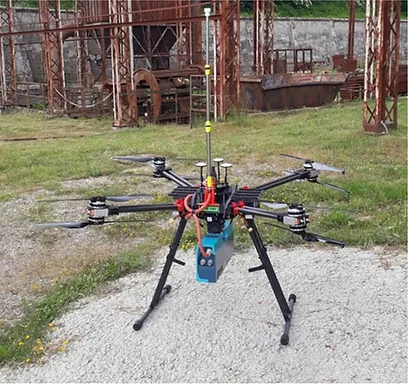Last year scientists in Italy mounted the RA-915M mercury vapor analyzer on an Unmanned Aerial Vehicle (UAV), specifically a heavy-life octocopter, to collect 3D spatial distribution data of gaseous elemental mercury (GEM) in air both inside and outside of a former mercury mining area of Abbadia San Salvatore.
Located near Mt. Amiata, Italy, the source produced over 100,000 tons of mercury between the years of 1870-1980, which resulted in heavy environmental pollution and the need for regular ecological monitoring as described in the article that was published in the Chemosphere Journal*. The effectiveness of the RA-915M-octocopter combination was tested at different heights in both mining facilities and surrounding urban zones which helped understand the GEM spatial distribution and concentration variability in those areas.

Taking advantage of the drone’s ability to land in small spaces and selected altitudes and with the goal of getting a detailed analysis of mercury levels at various geographical locations, the scientists:
- Synched the RA-195M with the UAV GPS by using a stand-alone GPS that had already been connected with the instrument;
- Used a vertical (vs horizontal) sampling tube nearly 4 feet long to compensate for the rotor airflow and turbulence;
- Powered the UAV with batteries to avoid having exhaust gas influence their readings.
Below is the resulting dot-map which demonstrates the data which was collected during the experiment. Fortunately, the scientists found the mercury concentration levels near reclaimed areas fell within acceptably low parameters. As expected, the highest levels of mercury were found to be around the buildings where the old furnaces were, with increasing concentrations either downwind of that location or at lower heights.

Conclusions
As stated in the referenced article, RA-915M “great sensitivity and the octocopter optimal versatility and maneuverability, both horizontally and vertically, allowed to depict the GEM distribution in the atmosphere up to 60 m above the ground”.
This type of measurement approach was significant because it helped overcome the limitations of both fixed measuring stations, which cannot take into account the GEM spatial variability, and passive samplers, which do not provide indications on concentration variations in short periods of time.
*Source: J. Cabassi, M. Lazzaroni, L. Giannini, D. Mariottini, B. Nisi, D. Rappuoli, O, Vaselli “Continuous and near real-time measurements of gaseous elemental mercury (GEM) from an Unmanned Aerial Vehicle (UAV): A new approach to investigate the 3D distribution of GEM in the lower atmosphere”
